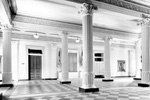The Pennsylvania Avenue lobby has also served as the location for several important memorials to those in the government's service. The first memorial was for the "service and suffering" of 243,135 horses and mules used by American forces in the first World War, in which 68,682 perished. The second memorial was for Diplomatic and Consular officers who while on active duty lost their lives under tragic or heroic circumstances such as epidemics, shipwrecks, or from foreign uprisings. The third memorial for the building's original architect, Alfred Mullett, remains in place on the east wall. The most recent memorial on the south wall honors President Eisenhower for his nearly eight years of service in the building as an Army o fficer and President.
Timeline
| 1879 to 1884 | North Wing built to include a ceremonial entrance lobby for the building. Ground breaking occurred on June 17, 1879 and the setting of the first granite four days later. |
| Feb. 1883 | Department of War staff move into the North Wing despite it not being fully finished. |
| Jun. 18, 1884 | Formal completion date of the North Wing at a cost of $1,914,501.99. |
| 1884 to 1888 | Lobby serves as the Department of War's main entry and used by all officers and visitors who came to call on the Secretary of War in the office directly above the lobby. The first Secretary of War to use this lobby was Robert Todd Lincoln, President Lincoln's son. He approved the color scheme for the office suite above the lobby and presumably reviewed and approved the lobby's color scheme too. |
| 1888 to 1938 | Lobby serves as the main entry for the Adjutant General and his staff after the Secretary of War moved his office suite to the building's West side. |
| Oct. 15, 1921 | Installation date of the lobby's first memorial. A bronze plaque commemorating the"services and suffering" of 243,135 horses and mules used by American forces in the first World War, of which 68,682 perished, was on the east wall and was formally presented the President of the American Humane Association and received by the Chief of the Calvary. Plaque removed in 1938. |
| Mar. 3, 1933 | Flanked by two silk American flags, a large marble memorial tablet on the north wall was unveiled by the Honorable Henry L. Stimson, Secretary of State, in honor of the Diplomatic and Consular officers who while on active duty lost their lives under tragic or heroic circumstances such as epidemics, shipwrecks, or from foreign uprisings. Over 60 names were engraved and gilded in the memorial designed by local DC architect, Waddy B. Wood. The memorial was moved to the current State Department building where it was rededicated in October 1954. |
| 1939 to 1947 | Lobby used as the Department of State's front door after the War Department moved from the building and the building's name changed to be the Department of State Building. |
| 1987 | Paint analysis determines the original colors from 1884. |
| 1988 | Renovations install a security post with turnstiles and x-ray monitoring of packages and the lobby was restored to its original colors. Memorial tablet to the building's original architect was installed on the east wall, where it still remains. |
| 2002 | Memorial to President Dwight Eisenhower installed on the South wall following the building's rededication to honor his nearly eight years of service in the building as an Army officer and President. |
